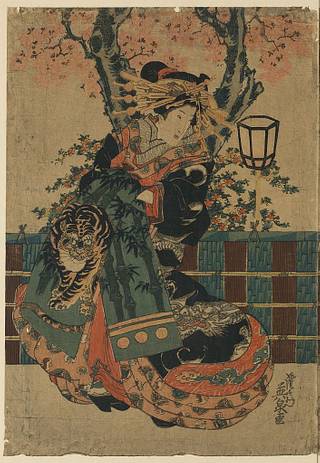
Similar
Nakano chō no sakura - Public domain print
Summary
Print shows three women, full-length portrait, standing, each with a different animal represented on their kimono, on the left should be a Chinese lion, center should be a tiger, and on the right is a turtle.
Woodblock printing in Japan (木版画, moku-hanga) is a technique best known for its use in the ukiyo-e artistic genre of single sheets, but it was also used for printing books in the same period. Woodblock printing had been used in China for centuries to print books, long before the advent of movable type, but was widely adopted in Japan during the Edo period (1603-1868). Woodblock printing appeared in Japan at the beginning of Edo period, when Tokugawa shogunate was ruled by the Japanese society. This technique originated from China, where it was used to print books for many centuries. Its original name is ‘moku-hanga’ and it has a wide usage in artistic genre of ‘ukiyo-e’. As opposed to western tradition, where artists used oil-based inks for woodcuts, moku-hanga technique uses water-based inks. That is why those prints had colors so vivid, as well as glazes, and transparency. This collection describes Japanese printmaking different schools and movements. The most notable of them were: - From 1700: Torii school - From 1700-1714: Kaigetsudō school - From 1720s: Katasukawa school, including the artists Shunsho and Shuntei - From 1725: Kawamata school including the artists Suzuki Harunobu and Koryusai - From 1786: Hokusai school, including the artists Hokusai, Hokuei and Gakutei - From 1794: Kitagawa school, including the artists Utamaro I, Kikumaro I and II - From 1842: Utagawa school, including the artists Kunisada and Hiroshige - From 1904: Sōsaku-hanga, "Creative Prints" movement - From 1915: Shin-hanga "New Prints" school, including Hasui Kawase and Hiroshi Yoshida Woodblock prints were provided by the Library of Congress and cover the period from 1600 to 1980.
Tags
Date
Contributors
Location
Source
Copyright info





































